Abstract
Previously, we reported the formation of a 2-deoxyribonolactone-containing nucleotide by UV irradiation of d(ApCpA). In this paper, we report some mechanical feature of this novel photoreaction. From the results of photolysis of d(GpCpG), this reaction is independent of neighboring bases. On photolysis of deoxycytidine at acidic pH, 2-deoxyribonolactone was produced with 74.2% isolated yield. And effects of some modifications of deoxycytidine were investigated. The results suggest that hydrates are possible intermediates for this reaction and the protonation may be essential not for deoxycytidine, but for the intermediates.
Full text
PDF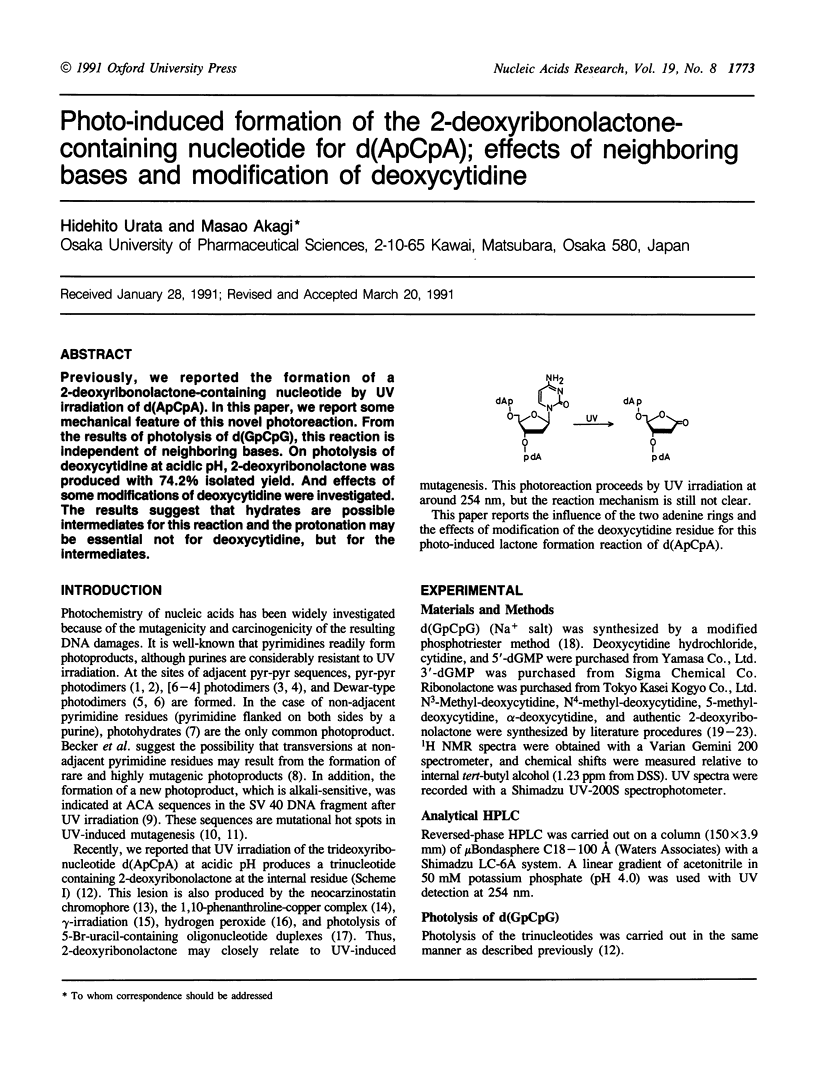
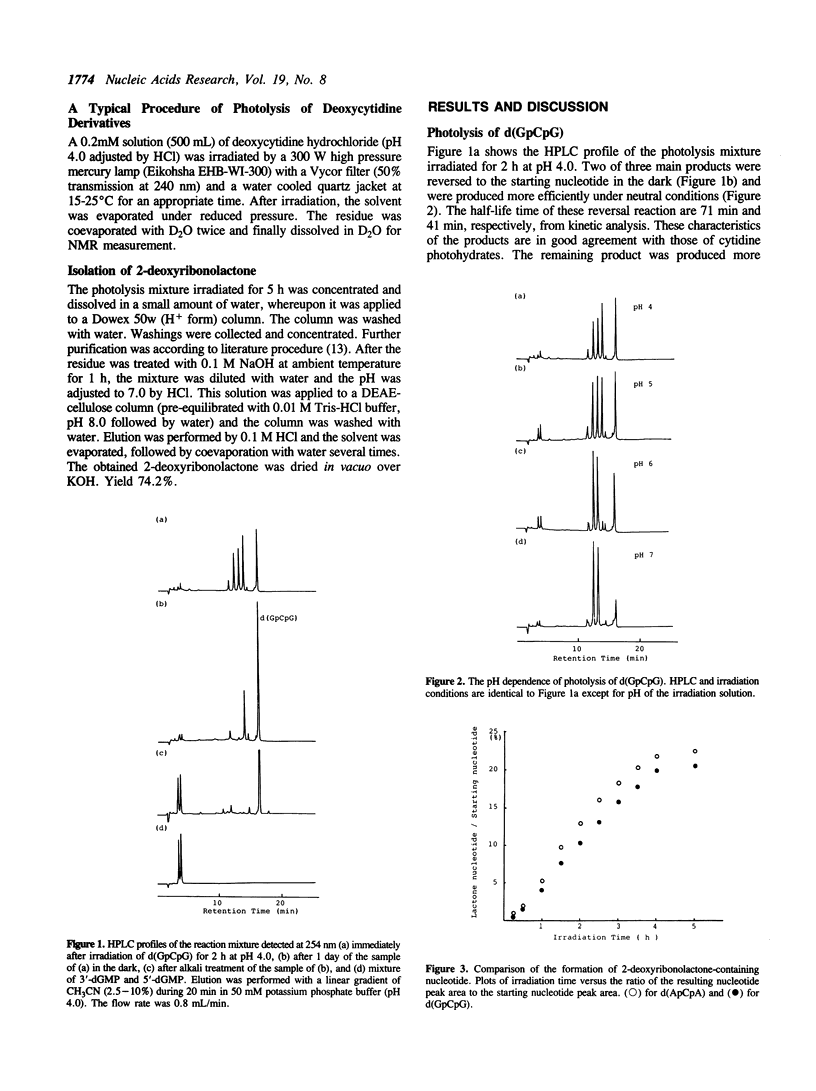
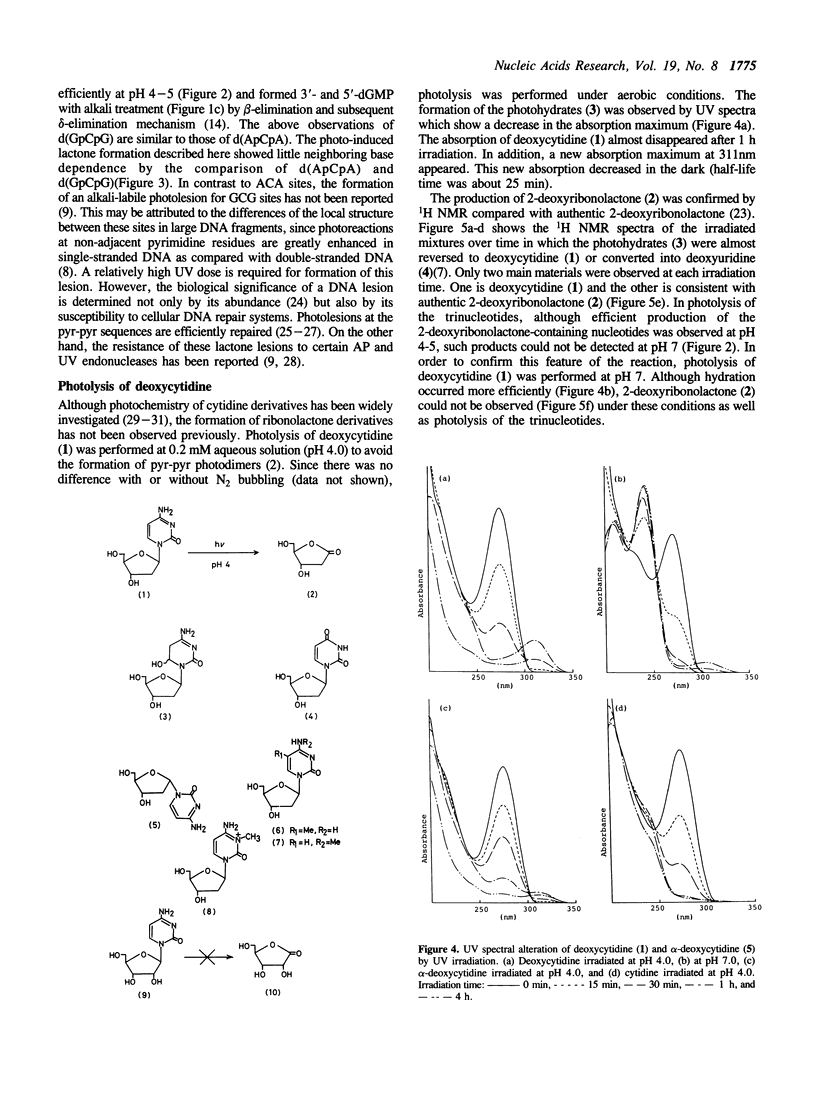
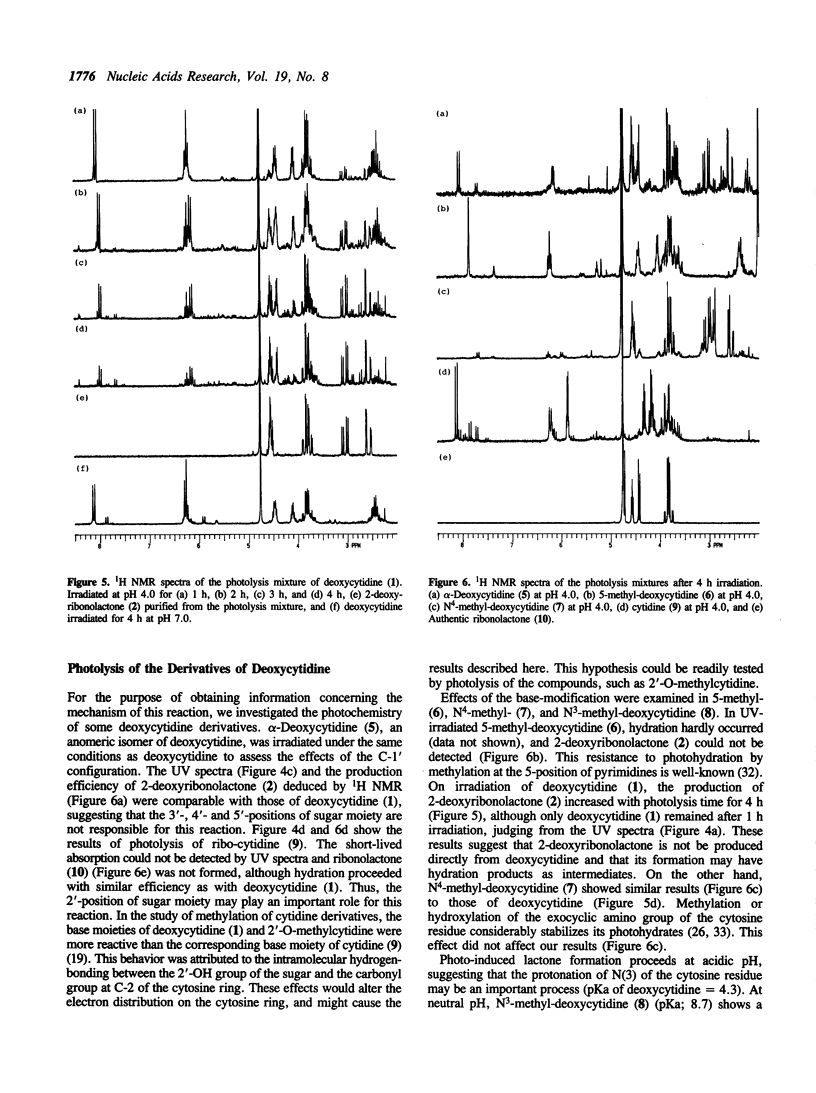
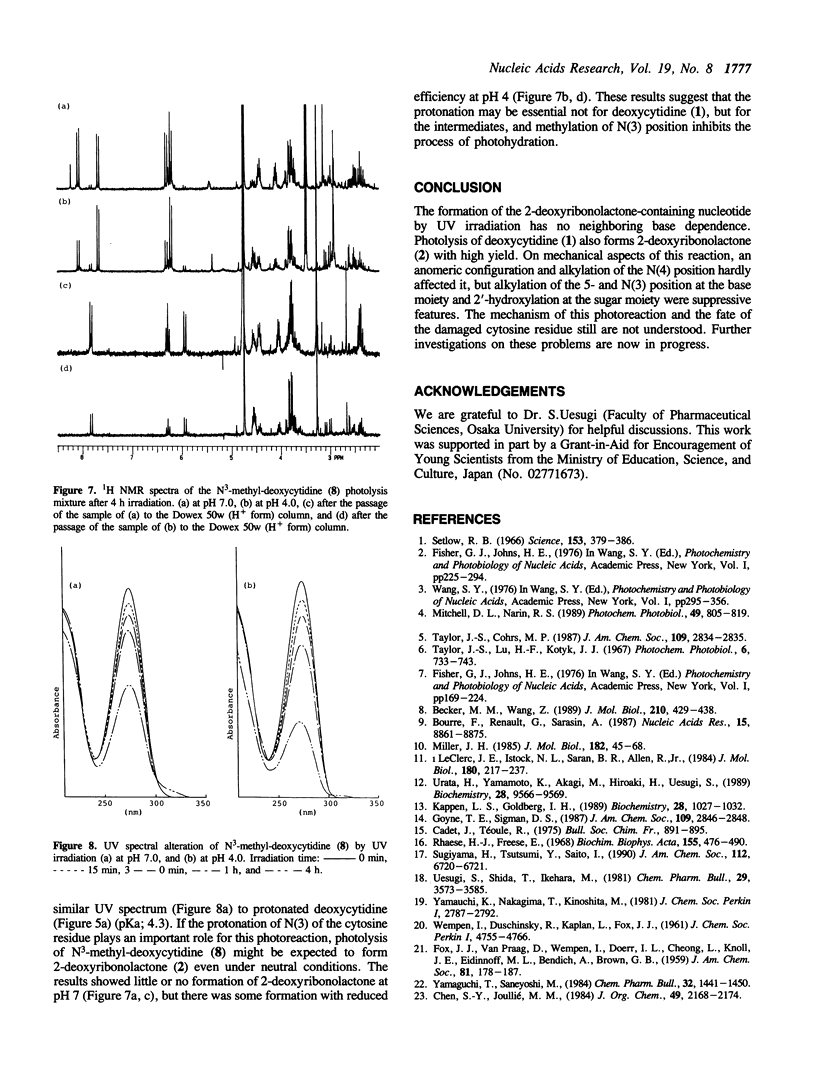
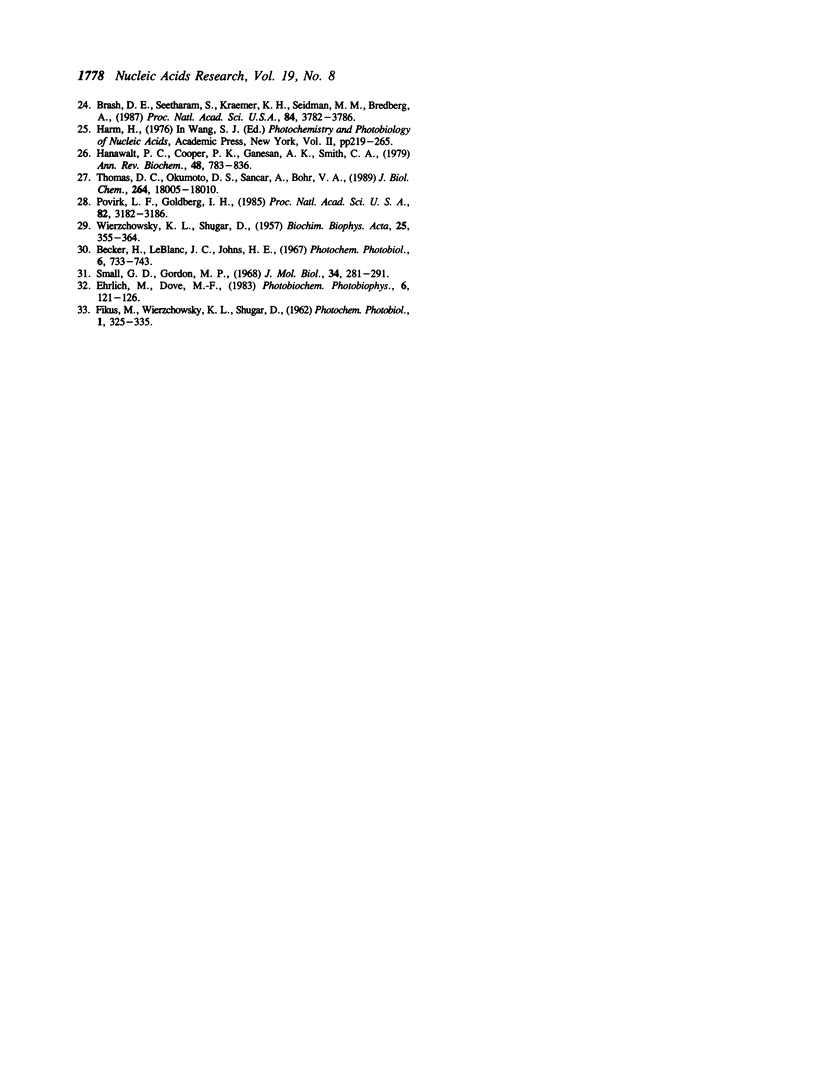
Selected References
These references are in PubMed. This may not be the complete list of references from this article.
- Becker H., LeBlanc J. C., Johns H. E. The U.V. photochemistry of cytidylic acid. Photochem Photobiol. 1967 Oct;6(10):733–743. doi: 10.1111/j.1751-1097.1967.tb08738.x. [DOI] [PubMed] [Google Scholar]
- Becker H., LeBlanc J. C., Johns H. E. The U.V. photochemistry of cytidylic acid. Photochem Photobiol. 1967 Oct;6(10):733–743. doi: 10.1111/j.1751-1097.1967.tb08738.x. [DOI] [PubMed] [Google Scholar]
- Becker M. M., Wang Z. Origin of ultraviolet damage in DNA. J Mol Biol. 1989 Dec 5;210(3):429–438. doi: 10.1016/0022-2836(89)90120-4. [DOI] [PubMed] [Google Scholar]
- Bourre F., Renault G., Sarasin A. Sequence effect on alkali-sensitive sites in UV-irradiated SV40 DNA. Nucleic Acids Res. 1987 Nov 11;15(21):8861–8875. doi: 10.1093/nar/15.21.8861. [DOI] [PMC free article] [PubMed] [Google Scholar]
- Brash D. E., Seetharam S., Kraemer K. H., Seidman M. M., Bredberg A. Photoproduct frequency is not the major determinant of UV base substitution hot spots or cold spots in human cells. Proc Natl Acad Sci U S A. 1987 Jun;84(11):3782–3786. doi: 10.1073/pnas.84.11.3782. [DOI] [PMC free article] [PubMed] [Google Scholar]
- Hanawalt P. C., Cooper P. K., Ganesan A. K., Smith C. A. DNA repair in bacteria and mammalian cells. Annu Rev Biochem. 1979;48:783–836. doi: 10.1146/annurev.bi.48.070179.004031. [DOI] [PubMed] [Google Scholar]
- Kappen L. S., Goldberg I. H. Identification of 2-deoxyribonolactone at the site of neocarzinostatin-induced cytosine release in the sequence d(AGC). Biochemistry. 1989 Feb 7;28(3):1027–1032. doi: 10.1021/bi00429a016. [DOI] [PubMed] [Google Scholar]
- LeClerc J. E., Istock N. L., Saran B. R., Allen R., Jr Sequence analysis of ultraviolet-induced mutations in M13lacZ hybrid phage DNA. J Mol Biol. 1984 Dec 5;180(2):217–237. doi: 10.1016/s0022-2836(84)80001-7. [DOI] [PubMed] [Google Scholar]
- Miller J. H. Mutagenic specificity of ultraviolet light. J Mol Biol. 1985 Mar 5;182(1):45–65. doi: 10.1016/0022-2836(85)90026-9. [DOI] [PubMed] [Google Scholar]
- Mitchell D. L., Nairn R. S. The biology of the (6-4) photoproduct. Photochem Photobiol. 1989 Jun;49(6):805–819. doi: 10.1111/j.1751-1097.1989.tb05578.x. [DOI] [PubMed] [Google Scholar]
- Povirk L. F., Goldberg I. H. Endonuclease-resistant apyrimidinic sites formed by neocarzinostatin at cytosine residues in DNA: evidence for a possible role in mutagenesis. Proc Natl Acad Sci U S A. 1985 May;82(10):3182–3186. doi: 10.1073/pnas.82.10.3182. [DOI] [PMC free article] [PubMed] [Google Scholar]
- Rhaese H. J., Freese E. Chemical analysis of DNA alterations. I. Base liberation and backbone breakage of DNA and oligodeoxyadenylic acid induced by hydrogen peroxide and hydroxylamine. Biochim Biophys Acta. 1968 Feb 26;155(2):476–490. [PubMed] [Google Scholar]
- Setlow R. B. Cyclobutane-type pyrimidine dimers in polynucleotides. Science. 1966 Jul 22;153(3734):379–386. doi: 10.1126/science.153.3734.379. [DOI] [PubMed] [Google Scholar]
- Small G. D., Gordon M. P. Reaction of hydroxylamine and methoxyamine with the ultraviolet-induced hydrate of cytidine. J Mol Biol. 1968 Jul 14;34(2):281–291. doi: 10.1016/0022-2836(68)90253-2. [DOI] [PubMed] [Google Scholar]
- Thomas D. C., Okumoto D. S., Sancar A., Bohr V. A. Preferential DNA repair of (6-4) photoproducts in the dihydrofolate reductase gene of Chinese hamster ovary cells. J Biol Chem. 1989 Oct 25;264(30):18005–18010. [PubMed] [Google Scholar]
- Urata H., Yamamoto K., Akagi M., Hiroaki H., Uesugi S. A 2-deoxyribonolactone-containing nucleotide: isolation and characterization of the alkali-sensitive photoproduct of the trideoxyribonucleotide d(ApCpA). Biochemistry. 1989 Dec 12;28(25):9566–9569. doi: 10.1021/bi00451a002. [DOI] [PubMed] [Google Scholar]
- WIERZCHOWSKI K. L., SHUGAR D. Photochemistry of cytosine nucleosides and nucleotides. Biochim Biophys Acta. 1957 Aug;25(2):355–364. doi: 10.1016/0006-3002(57)90479-1. [DOI] [PubMed] [Google Scholar]
- Yamaguchi T., Saneyoshi M. Synthetic nucleosides and nucleotides. XXI. On the synthesis and biological evaluations of 2'-deoxy-alpha-D-ribofuranosyl nucleosides and nucleotides. Chem Pharm Bull (Tokyo) 1984 Apr;32(4):1441–1450. doi: 10.1248/cpb.32.1441. [DOI] [PubMed] [Google Scholar]


